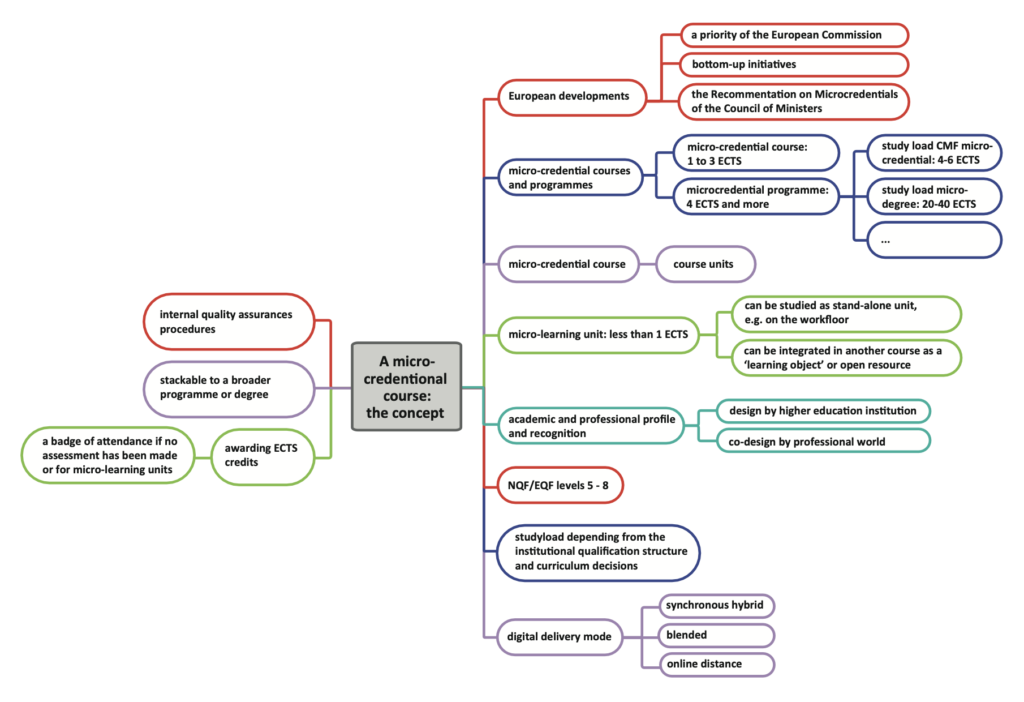
Guidelines
Because of the involvement of different universities, designing and developing a joint micro-credential course is a complex activity, consisting of several steps:
• connect with institutional and cross-institutional policies and strategies, for example in the case of the European Universities Initiative (European Commission, 2021c), more specifically related to continuing education and professional development.
• share with the partner universities a joint vision on the course. Define the macro-objectives, based on a needs analysis and learner characteristics. Develop an academic and professional profile and determine specific course settings for meeting lifelong learners’ living and working conditions. Develop a unique selling point, developing synergies with other universities for a higher quality and making the course internationally attractive for continuing education.
• compose the joint course team, led by a course team leader with scientific and educational authority. Share leadership with key teaching staff of the respective institutions and involve them in the design and development of the course;
• ensure (cross-)institutional professional support through teaching and learning, internationalisation, ICT for education, legal services and student administration. All are needed in the design and development phase of the joint course;
• design the joint course according to current pedagogical principles so that it can be successfully developed and implemented: define learning outcomes and competences, develop a course plan and distribute the design and development tasks across the partnership, design and sequence learning activities, design modular course units, improve the student’s learning experience, define modes of delivery, design course interactions, select and align media and tools, design space for flexibility; determine the study load; and make the course inclusive;
• if appropriate, design micro-learning units, based on course units or developed
from scratch in co-creation with stakeholders, transferring knowledge for professional development in the workplace, taking into account the demand for competences/skills and the development of core attitudes (21st century skills);
• decide with the partners on the delivery platform for the joint course;
• agree on a coherent approach on formative and summative assessment and feedback. Determine joint examination regulations.
• justify and agree on a joint award to be granted, for example credit points or a badge aligned with institutional and national qualification structures for continuing education and professional development. It is expected that these structures will be further developed following the Proposal for a Recommendation of the European Commission to the Council of Ministers on Micro-credentials (2022-2025);
• install a language policy in line with the international ambitions for the course;
• Define an admission framework for the course and develop a student recruitment plan, including multi-segment recruitment campaigns;
• make agreements on a common scheme for quality assurance, linked to institutional frameworks and based on ESG and the Guidelines for e-learning (ENQA, 2015; Huertas et al., 2018);
• develop a joint business plan, balancing public and private funding and tuition fees within broader institutional frameworks for continuing education;
• develop a sustainability framework with a multi-year commitment from universities to ensure basic sustainability, a regular institutional review and improvement plan and a medium-term financial plan;
• conclude a consortium agreement in which responsibilities and tasks are laid down.
Observations
• Universities in the EUI alliances cooperate in many areas for continuing education and professional development, providing a natural environment for joint micro-credential course and programme development;
• Efforts for (online) continuing education and professional development are being strengthened and streamlined in leading universities, for example by creating “extension schools” or centres for continuing education;
• There is growing demand for micro-credential courses and programmes which are stackable to larger microdegree and degree programmes. At the same time, there is demand for small and very small microlearning units (less than 1 ECTS), e.g. for workplace learning;
• This argues for modular education that is at all times adapted to the current time horizon of the learners. However, micro-credentials and standalone microlearning units require a specific approach to learners’ needs, so their design may require an own approach to learners’ needs. A course or programme module is therefore not necessarily equivalent to a standalone micro-credential or microlearning unit.
• The MOOC platforms in the European MOOC Consortium and the universities linked
to them are developing MOOC pathways and have agreed on micro-credential standards according to the Common Micro-credential Framework (CMF). These micro-credentials of 4 to 6 ECTS are stackable into broader micro-credential and degree programmes;
• The European Commission and the Council of Education Ministers are preparing a micro-credential framework (Recommendation, 2021; implementation, 2025) to promote the development of lifelong learning and professional development;
• Expertise in the design and development of joint courses and programmes and related mobility is increasing at all levels, for example through the involvement of universities in Erasmus Mundus masters programmes. This supports the scientific basis for designing and developing joint micro-credentials.
next chapter: Align with institutional and cross-institutional policies
previous chapter: A joint micro-credential course: the concept
back to overview: Models and guidelines for the design and development of
joint micro-credential courses and microlearning units in higher education
